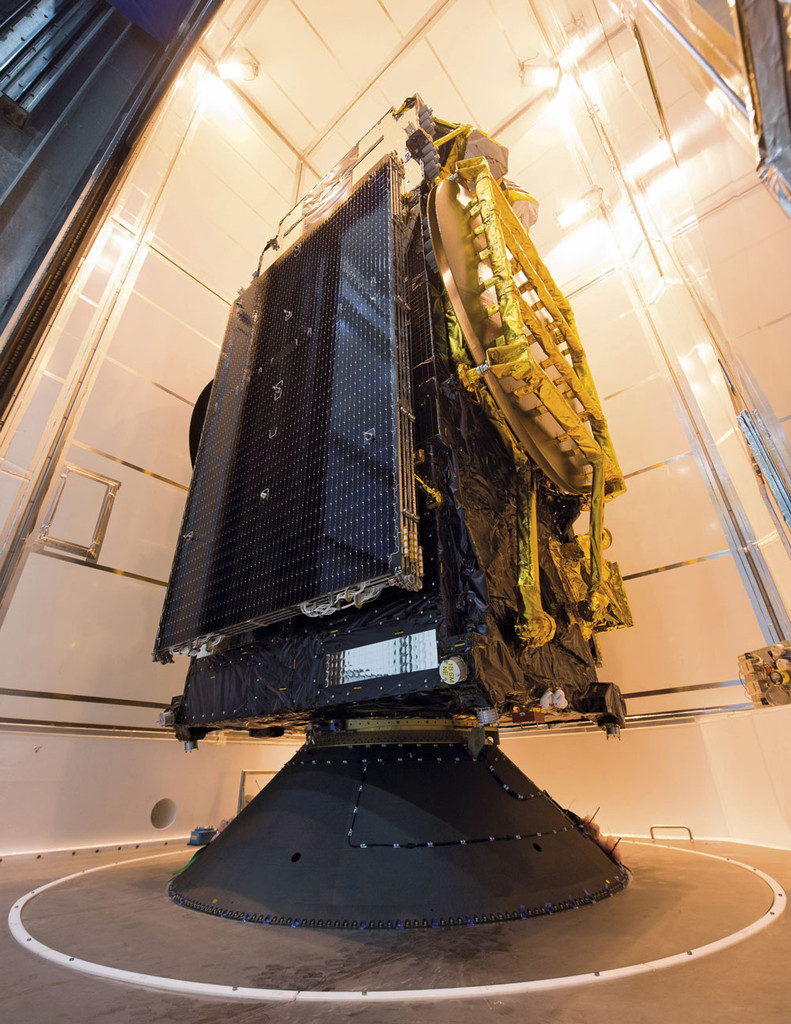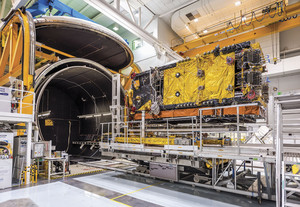
ESA-CNES-Arianespace
French Guiana: final stage of preparation before being mounted in the Ariane rocketESA-CNES-ArianespaceA new communications satellite for Brazil was launched into space on May 4, 2017 at the Kourou Space Center in French Guiana. Besides providing Brazil with greater autonomy in civil and military communications, the Geostationary Satellite for Defense and Strategic Communications (SGDC) will also lead to significant gains for the Brazilian aerospace industry because the acquisition agreement entered into with the French-Italian manufacturer Thales Alenia Space included technology transfer to Brazilian companies in the sector. The SGDC will provide an internet signal to all Brazilian municipalities and will be the backbone of the Armed Forces communications system. Currently, satellites used by Brazil, both for civil and military communications, are managed by land stations located outside the country or controlled by companies with foreign capital. “In both cases, the country is vulnerable, because there is the risk that the confidentiality of the information could be violated and the service could be interrupted in a situation in which there is a conflict of interest, causing some telecommunications services to collapse,” said Eduardo Bonini, president of Visiona Tecnologia Espacial, in the city of São José dos Campos, São Paulo State, the company coordinating the project.
The fruit of a partnership between the Ministry of Science, Technology, Innovation and Communications (MCTIC) and the Ministry of Defense, the SGDC project cost R$2.1 billion. The satellite will be operated by Telebras, in two frequency bands. The Ka band, corresponding to 70% of its capacity, will be used to increase broadband service in Brazil under the National Broadband Program (PNBL), which will provide quality internet services to regions lacking suitable infrastructure and technology. The X band, using the remaining 30%, will be for military use.
Weighing 5.8 metric tons and measuring 7 meters in height, the satellite is orbiting 36,000 kilometers above the Earth’s surface. SGDC should be fully operational within six months of launching, and during this period it will undergo technical adjustments and be positioned in the exact location necessary to cover all of Brazil and part of the Atlantic Ocean. The useful life of the equipment is estimated at 18 years. Development began in November 2013, when Telebras contracted Visiona to coordinate the project. The company, a joint venture between Embraer and Telebras itself, had been created a year earlier with a focus on space-system integration.
 “Since at that time Brazil did not have companies with technological know-how to design and build a satellite with the size and specifications of the SGDC, we looked for an international supplier among the big global companies in the sector,” says Bonini. At the end of a year-long selection process, French-Italian Thales Alenia Space was chosen as the supplier. Another company, Arianespace, was responsible for putting the satellite into orbit. The French multinational operates Ariane rockets from its launch base in Kourou, French Guiana.
“Since at that time Brazil did not have companies with technological know-how to design and build a satellite with the size and specifications of the SGDC, we looked for an international supplier among the big global companies in the sector,” says Bonini. At the end of a year-long selection process, French-Italian Thales Alenia Space was chosen as the supplier. Another company, Arianespace, was responsible for putting the satellite into orbit. The French multinational operates Ariane rockets from its launch base in Kourou, French Guiana.
Techonology transfer
An important aspect of the agreement signed by Visiona and Thales is a clause that obliges the French manufacturer to pass on satellite-based technology to Brazilian companies and agencies. Thales, through the contract, shared many space technologies, as agreed upon during the selection phase. In addition to technology transfer, a Space Technology Absorption Plan (PAT) was also formulated, coordinated by the Brazilian Space Agency (AEB) with contributions from Visiona, the National Institute for Space Research (INPE), the Ministry of Defense, MCTIC and Telebras. Fifty-one Brazilian engineers employed by these institutions were sent to Thales, in Cannes and Toulouse, France. For three years, they took part in developing the satellite, from the design and engineering phases to the construction of the equipment and its integration into the Ariane V rocket.
The engineers performed simulations of orbit and attitude maintenance (position of the satellite in relation to Earth), assembly, integration and testing of modules and various parts of the space equipment, as well as building subsystems. According to Bonini, this cooperation allowed Brazilian engineers to learn how to develop orbital attitude control software, which, in his view, is the biggest obstacle to manufacturing satellites in Brazil. “This program ensured that engineers participated in the development of the SGDC, working side-by-side with Thales technicians and leaders in all phases of the project,” says Petrônio Noronha de Souza, AEB director of Space Policies and Strategic Investments.
 Begun in 2014, PAT also trained Telebras professionals and the military who will work at the satellite control stations, located at Brasília Air Force Base and on the Navy’s base on Governador Island, in Rio de Janeiro State. According to Souza, with the experience gained during the construction of the satellite, the engineers will also be able to work on future civilian and military space projects. These could include those in the National Space Activities Program (PNAE) and the Strategic Space Systems Program (PESE), which provide for the construction of other Brazilian satellites at least partly by Brazilian companies.
Begun in 2014, PAT also trained Telebras professionals and the military who will work at the satellite control stations, located at Brasília Air Force Base and on the Navy’s base on Governador Island, in Rio de Janeiro State. According to Souza, with the experience gained during the construction of the satellite, the engineers will also be able to work on future civilian and military space projects. These could include those in the National Space Activities Program (PNAE) and the Strategic Space Systems Program (PESE), which provide for the construction of other Brazilian satellites at least partly by Brazilian companies.
In addition to training human resources through PAT, the SGDC agreement included a Space Technology Transfer (ToT) Agreement signed by Thales and AEB. The document provided for the transfer of around 20 critical satellite technologies from the French company to Brazilian manufacturers, including attitude control software, propulsion system components and various electronic systems. In January 2015, AEB announced the result of a public call for proposals with the name of the first five companies participating in the program—one from Rio Grande do Sul and four from the state of São Paulo.
Integrated knowledge
Fibraforte Engenharia, in the city of São José dos Campos, was selected to receive technical training focused on mastering the development cycle of the single-fuel propulsion system for small satellites. Similarly, Orbital Engenharia, in the same city, will absorb technologies applicable to the construction of solar-power systems and generators for satellites. Another company, AEL Sistema, based in the city of Porto Alegre, will receive technology transfer of two types of integrated circuits for applications embedded in satellites.

ESA-CNES-Arianespace
At Thales Alenia Space in France, the SGDC enters a thermal vacuum chamber that simulates the space environmentESA-CNES-ArianespaceLocated in the Univap Technological Park in São José dos Campos, Equatorial Sistemas was designated to receive heat control technologies for satellites, and Cenic Engenharia, in the same city, was tasked with developing carbon-fiber-based mechanical structures for Earth observation payloads, such as optical cameras.
“The five companies are fulfilling project needs and receiving periodic assistance from Thales. We intend to announce a new call for proposals and select more companies to join the program. Under the agreement with Thales, we can implement technology transfer within two years after launching the satellite, which we are already doing,” explains AEB’s Petrônio Souza. According to him, the next Brazilian communications satellite will already have equipment developed by domestic companies.
“In the short- and medium-term, we will not be able to make a satellite with this degree of complexity, but we will be able to implement different domestic additions”, he analyzes. Bonini, of Visiona, announced that the company is already testing an attitude and orbit control system totally developed in Brazil. If successful, it can be used in future Brazilian satellites.

ESA-CNES-Arianespace
The solar panels are openESA-CNES-ArianespaceWith the SGDC, Brazil returns to the small group of countries whose governments rely on their own geostationary communications satellite, which is always at the same fixed point in space, over the equator at an altitude of 35,786 kilometers, moving at the same speed as Earth.
In 1985, Brazil joined this group with Brasilsat A1, launched by Empresa Brasileira de Telecomunicações (Embratel). “Embratel, as a state-owned company, was a pioneer when it launched Brazil’s first geostationary communications satellite, the Brasilsat A1, essentially for civil use, in 1985. Nine years later, while still state-owned, the company activated Brasilsat B1, the first Brazilian civil and military geostationary satellite. It was later deactivated in 2010,” says Lincoln Oliveira, CEO of Embratel Star One, the current name of the company, which was privatized in 1998. The B3 and B4 followed, the latter during the period in which the government had already decided to privatize Brazilian telecommunications.
In addition to the SGDC, Brazil uses about 45 communications satellites, all belonging to private companies such as Globalstar, Iridium and Embratel Star One, which owns the largest satellite fleet in Brazil and Latin America. Today, Embratel Star One is a multinational, part of the Mexican group America Movil, which also owns the mobile telephone operator Claro. It controls nine satellites in Brazil, including Star One C1 and C2, used by the Brazilian Military.

ESA-CNES-Arianespace
Assembly of the 7-meter-high satellite required both French technicians and 51 Brazilian engineersESA-CNES-ArianespaceRemote sensing
Integration all SGDC components is the main task of Visiona, whose staff includes about 30 engineers, almost all with master’s degrees, doctorates and experience through the Space Technology Absorption Plan. “Many of our professionals have worked at INPE for years and have a lot of experience,” says Bonini. According to him, by coordinating the SGDC program, the company was able to prepare itself for other challenges. “We are now able to build smaller satellites, weighing about 100 kilos, for low orbits ranging from 600 to 1,000 kilometers, for applications such as remote sensing, meteorology, observation and data collection,” says the president of Visiona.
Until the demand for new devices increases, the company is counting on another business area: the development of remote sensing projects in Brazil and neighboring countries in sectors such as defense, environmental protection, natural disaster prevention, energy and territorial planning. The company earned R$8.5 million in 2016 for this service and contributed to important projects with INPE, in the fight against deforestation in the Amazon, and with Petrobras, for environmental monitoring of the Campos Basin, in Rio de Janeiro. In order to achieve this, Visiona, which does not own any satellites, signed agreements to purchase images from some of the principal Earth-observation satellite operators, such as Airbus, DigitalGlobe, Restec and SI Imaging Services. In all, it will have access to a network of about 28 satellites. “These partnerships allow us to develop integrated, remote-sensing solutions,” says Bonini.
Republish
